Raise Your Experience with Bagley Risk Management
Raise Your Experience with Bagley Risk Management
Blog Article
Recognizing Animals Danger Protection (LRP) Insurance Coverage: A Comprehensive Guide
Navigating the realm of livestock danger security (LRP) insurance coverage can be an intricate venture for lots of in the farming sector. From just how LRP insurance coverage works to the numerous coverage choices readily available, there is much to discover in this comprehensive overview that can potentially form the way animals producers come close to threat management in their organizations.

Exactly How LRP Insurance Policy Functions
Occasionally, understanding the technicians of Animals Danger Defense (LRP) insurance policy can be complicated, however breaking down how it functions can give clearness for farmers and breeders. LRP insurance coverage is a risk management tool developed to safeguard livestock manufacturers against unforeseen rate decreases. It's important to note that LRP insurance policy is not an income assurance; rather, it concentrates entirely on rate threat security.
Eligibility and Coverage Options

When it comes to protection options, LRP insurance policy provides producers the flexibility to select the insurance coverage degree, insurance coverage period, and endorsements that best suit their danger management demands. By recognizing the eligibility criteria and coverage alternatives available, animals producers can make informed choices to handle risk successfully.
Advantages And Disadvantages of LRP Insurance
When assessing Animals Risk Defense (LRP) insurance policy, it is essential for animals producers to weigh the disadvantages and benefits fundamental in this risk management tool.

One of the key advantages of LRP insurance coverage is its capacity to offer security versus a decline in animals prices. Additionally, LRP insurance policy offers a level of versatility, enabling producers to personalize protection levels and plan durations to suit their details demands.
Nevertheless, there are likewise some downsides to consider. One limitation of LRP insurance is that it does not secure versus all sorts of threats, such as disease outbreaks or all-natural disasters. Premiums can occasionally be pricey, especially for manufacturers with large livestock herds. It is crucial for manufacturers to carefully assess their specific threat direct exposure and financial scenario to identify if LRP insurance policy is the ideal danger management tool for their procedure.
Understanding LRP Insurance Coverage Premiums

Tips for Making The Most Of LRP Conveniences
Making best use of the advantages of Animals Risk Security (LRP) insurance needs calculated preparation and positive threat administration - Bagley Risk Management. To maximize your LRP protection, think about the adhering to tips:
Frequently Examine Market Conditions: Keep educated regarding market patterns and cost variations in the animals industry. By checking these aspects, you can make enlightened choices concerning when to purchase LRP coverage to protect versus possible losses.
Set Realistic Protection Degrees: When picking coverage levels, consider your manufacturing costs, market price of livestock, and possible threats - Bagley Risk Management. Setting sensible coverage levels makes sure that you are adequately secured without overpaying for unneeded insurance policy
Diversify Your Insurance Coverage: As opposed to depending solely on LRP insurance, think about diversifying web link your threat administration techniques. Incorporating LRP with other threat administration tools such as futures agreements or options can supply comprehensive coverage against market uncertainties.
Testimonial and Change Insurance Coverage Frequently: As market conditions transform, periodically examine your LRP coverage to ensure it lines up with your existing threat direct exposure. Readjusting protection degrees and timing of acquisitions can assist optimize your threat protection technique. By adhering to these ideas, you read this article can maximize the advantages of LRP insurance and protect your livestock procedure against unanticipated risks.
Final Thought
In final thought, animals threat protection (LRP) insurance policy is a valuable device for farmers to take care of the monetary risks connected with their animals operations. By comprehending just how LRP functions, eligibility and protection choices, in addition to the advantages and disadvantages of this insurance coverage, farmers can make enlightened choices to protect their source of incomes. By very carefully considering LRP costs and executing strategies to maximize advantages, farmers can alleviate potential losses and ensure the sustainability of their procedures.
Livestock producers interested in acquiring Animals Threat Defense (LRP) insurance coverage can explore an array of eligibility criteria and protection alternatives customized to their details livestock procedures.When it comes to insurance coverage choices, LRP insurance coverage offers producers the versatility to choose the insurance coverage level, coverage duration, and recommendations that ideal match their danger administration requirements.To grasp the ins and outs of Animals Danger Protection (LRP) insurance coverage fully, recognizing the elements influencing LRP insurance premiums is crucial. LRP insurance policy premiums are established by different elements, consisting of the protection degree picked, the anticipated price of livestock at the end of the insurance coverage duration, the type of livestock being guaranteed, and the size of the protection period.Review and Change Coverage Routinely: As market problems alter, occasionally evaluate your LRP protection to ensure it aligns with your current danger direct exposure.
Report this page